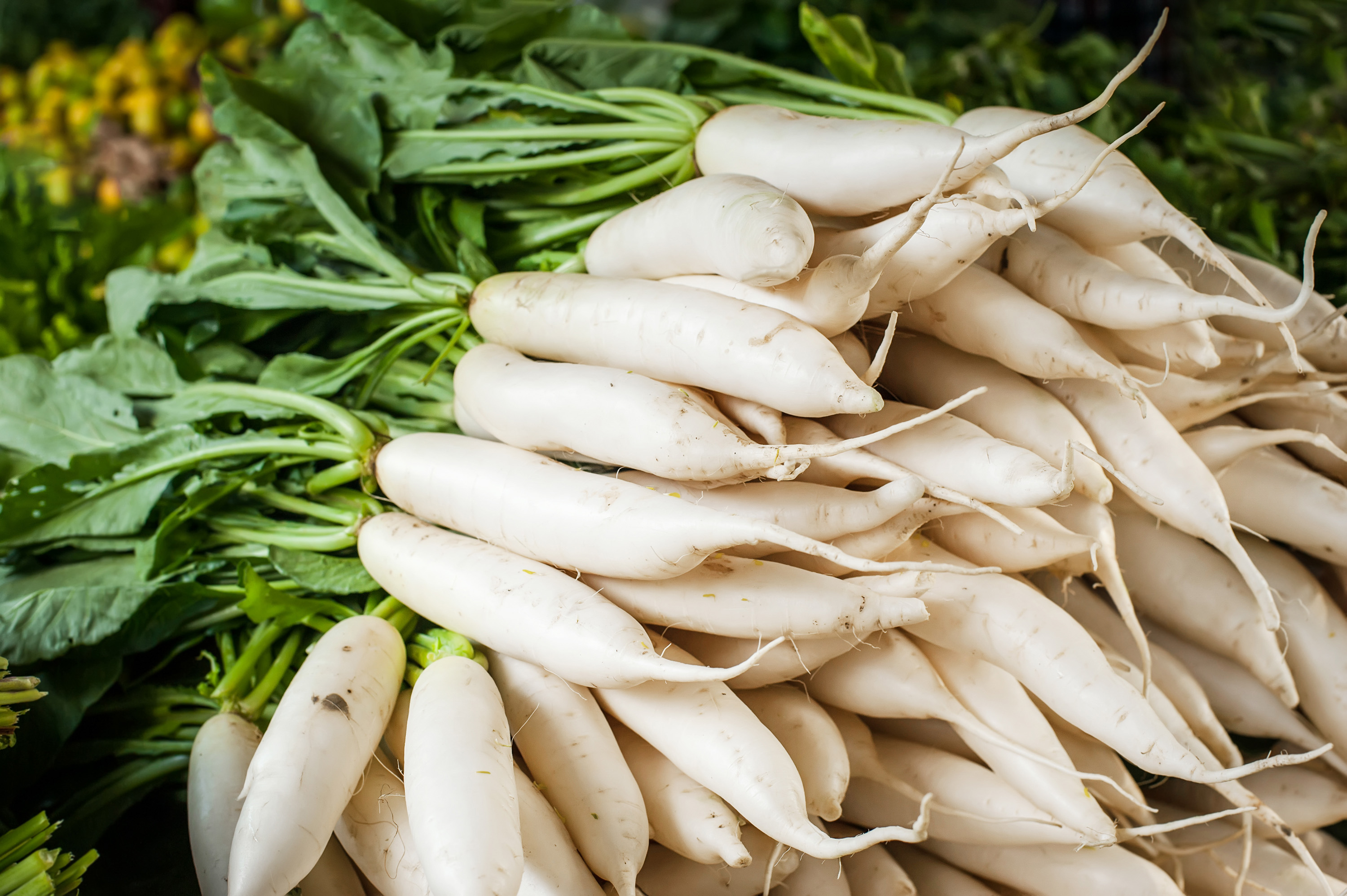
Cultivation of Radish (Raphanus sativus)
Radish is an important root vegetable cultivated for its edible roots, which are consumed raw in salads or cooked. It is a fast-growing crop with a short duration, making it suitable for multiple cropping systems.
Origin, Area, and Distribution
- Origin: Central and South Asia.
- Global Distribution: Widely cultivated in Japan, China, India, USA, France, and Netherlands.
- India Distribution: Major growing states include Punjab, Haryana, Uttar Pradesh, Bihar, West Bengal, and Karnataka.
Climate Requirements
- Climate: Radish is a cool-season crop, though some tropical varieties are grown in warmer climates.
- Optimum Temperature:
- For germination: 10°C–15°C.
- For root development: 15°C–25°C.
- Season:
- Temperate regions: Grown during spring and autumn.
- Tropical regions: Grown year-round with suitable varieties.
Soil Requirements
- Soil Type: Well-drained, loose sandy loam or loam soils are ideal for uniform root development.
- pH Range: 6.0–7.0.
- Preparation: Deep plowing followed by fine tilth preparation ensures straight roots.
Improved Varieties
- Desi Varieties:
- Pusa Chetki: Suitable for summer sowing.
- Pusa Desi: Grown during winter in north India.
- Japanese White: Large, long roots suitable for salads.
- Kalyanpur No. 1: High-yielding winter variety.
- Hybrid Varieties:
- Jaunpuri Giant: Large roots, suitable for export.
- Arka Nishant: High-yielding hybrid.
Seed Rate: Seed Rate: 8–10 kg/ha, depending on variety and spacing.
Time of Sowing
- Winter Varieties: October to November.
- Summer Varieties: March to June.
- Rainy Season: July to September (short-duration varieties).
Sowing Method
- Spacing:
- Row-to-row distance: 30–45 cm.
- Plant-to-plant distance: 8–10 cm.
- Depth: Sow seeds 1.5–2 cm deep.
- Thinning: Perform thinning after 15–20 days to maintain proper spacing.
Fertilizer Requirements
- Nutrient Management:
- Nitrogen (N): 50–60 kg/ha.
- Phosphorus (P): 25–30 kg/ha.
- Potassium (K): 25–30 kg/ha.
- Application Schedule:
- Apply phosphorus and potassium as a basal dose.
- Split nitrogen into two doses, one as a basal dose and the other 25–30 days after sowing.
Irrigation
- Frequency: Radish requires frequent, light irrigations to maintain soil moisture.
- Irrigate at intervals of 5–7 days, depending on the season.
- Avoid water stagnation as it can lead to root rot.
Weed Management
- Perform manual weeding or hoeing after 2–3 weeks of sowing.
- Mulching can be used to suppress weed growth and conserve moisture.
Intercultural Operations
- Perform light hoeing for aeration and better root growth.
- Ensure proper thinning to prevent overcrowding.
Pest and Disease Management
Pests:
- Aphids: Suck sap from leaves and cause curling. Control: Spray Imidacloprid (0.5 ml/liter of water).
- Cutworms: Damage seedlings and roots. Control: Use Chlorpyrifos as soil treatment.
Diseases:
- Clubroot: Affects root development, causing swelling. Control: Maintain soil pH around 7.0 and use disease-free seeds.
- Downy Mildew: Yellow patches on leaves. Control: Spray Mancozeb or Chlorothalonil.
Harvesting
- Maturity Period: Early varieties mature in 25–30 days. Late varieties take 50–70 days.
- Signs of Maturity: Roots attain full size with a firm texture. Leaves start yellowing slightly.
- Method: Uproot plants manually or use hand tools.
Post-Harvest Handling
- Washing: Clean roots to remove soil and debris.
- Grading: Grade based on size, shape, and uniformity.
- Storage: Store at 0°C–2°C with 90–95% relative humidity to maintain freshness.
Yield
- Average Yield:
- Early varieties: 8–10 tons/ha.
- Late varieties: 15–20 tons/ha.
Physiological Disorders
- Forking of Roots:
- Cause: Hard or stony soil.
- Management: Ensure proper soil preparation and avoid excessive nitrogen.
- Pithiness:
- Cause: Over-mature roots or uneven moisture.
- Management: Harvest at the right stage and ensure consistent watering.
- Splitting of Roots:
- Cause: Sudden excessive moisture after drought.
- Management: Avoid irregular irrigation practices.

Cultivation of Beetroot (Beta vulgaris)
Beetroot is a popular root vegetable grown for its edible roots, which are consumed fresh, cooked, or processed. Its vibrant color and nutritional value make it a favorite among health-conscious consumers. It also has applications in food coloring and traditional medicine.
Origin, Area, and Distribution
- Origin: Mediterranean region.
- Global Distribution: Widely grown in USA, Russia, UK, France, Germany, and India.
- India Distribution: Cultivated in Punjab, Haryana, Uttar Pradesh, Bihar, West Bengal, Maharashtra, and Tamil Nadu.
Climate Requirements
- Climate: Beetroot is a cool-season crop.
- Optimum Temperature:
- For germination: 18°C–25°C.
- For growth: 15°C–20°C.
- Season:
- Temperate regions: Grown in summer.
- Tropical and subtropical regions: Grown in winter.
Soil Requirements
- Soil Type: Well-drained, sandy loam or loam soil with good organic matter is ideal.
- pH Range: 6.0–7.5.
- Soil Preparation: Deep plowing followed by fine tilth preparation. Add well-decomposed organic manure before sowing.
Improved Varieties
- Indian Varieties:
- Crimson Globe: High-yielding variety with uniform round roots.
- Detroit Dark Red: Early maturing variety with smooth, deep red roots.
- Punjab Noor: Grown widely in northern India.
- Exotic Varieties:
- Red Ace: Known for its high sugar content.
- Crosby Egyptian: Early maturing, flat globe-shaped roots.
- Chioggia: Distinctive red and white concentric rings.
Seed Rate
- Seed Rate: 8–10 kg/ha.
- Seed Treatment: Treat seeds with Thiram or Captan (2 g/kg of seed) to prevent fungal infections.
Time of Sowing
- Tropical and Subtropical Regions: October to February.
- Temperate Regions: March to May.
Sowing Method
- Spacing:
- Row-to-row distance: 30–45 cm.
- Plant-to-plant distance: 10–15 cm.
- Depth: Sow seeds 2–3 cm deep.
- Thinning: Thin seedlings at 4–6 weeks to avoid overcrowding.
Fertilizer Requirements
- Nutrient Management:
- Nitrogen (N): 50–60 kg/ha.
- Phosphorus (P2O5): 40–50 kg/ha.
- Potassium (K2O): 40–50 kg/ha.
- Application Schedule:
- Apply phosphorus and potassium as a basal dose.
- Split nitrogen into two doses: basal and at 4 weeks after sowing.
Irrigation
- Frequency: Requires regular and light irrigation. Irrigate at intervals of 7–10 days, depending on soil type and weather.
- Critical Stages: Ensure moisture during root enlargement.
Weed Management
- Perform manual weeding or use pre-emergence herbicides like Pendimethalin (1.0 kg/ha).
- Mulching helps suppress weeds and conserve soil moisture.
Intercultural Operations Light hoeing is necessary to aerate the soil and ensure proper root development.
Pest and Disease Management
Pests:
- Leaf Miners: Create tunnels in leaves, reducing photosynthesis. Control: Spray Dimethoate (2 ml/liter of water).
- Cutworms: Feed on seedlings and roots. Control: Apply Chlorpyrifos to the soil.
Diseases:
- Cercospora Leaf Spot: Causes circular spots on leaves. Control: Use fungicides like Mancozeb or Carbendazim.
- Downy Mildew: Yellow patches on leaves. Control: Spray Metalaxyl or Chlorothalonil.
Harvesting
- Maturity Period: 90–120 days, depending on variety.
- Signs of Maturity:
- Roots reach the desired size (5–10 cm in diameter).
- Leaves start yellowing slightly.
- Method: Uproot manually or use hand tools.
Post-Harvest Handling
- Washing: Clean roots to remove soil and debris.
- Grading: Grade based on size, shape, and uniformity.
- Storage: Store at 0°C–4°C with 90–95% relative humidity for long shelf life.
Yield: Average Yield: 15–20 tons/ha, depending on variety and management practices.
Physiological Disorders
- Forking of Roots: Cause: Hard or compacted soil. Management: Ensure proper soil preparation.
- Black Heart: Cause: Boron deficiency. Management: Apply Boric acid (10 kg/ha) as a soil amendment.
- Splitting of Roots: Cause: Uneven water supply. Management: Maintain consistent irrigation.

